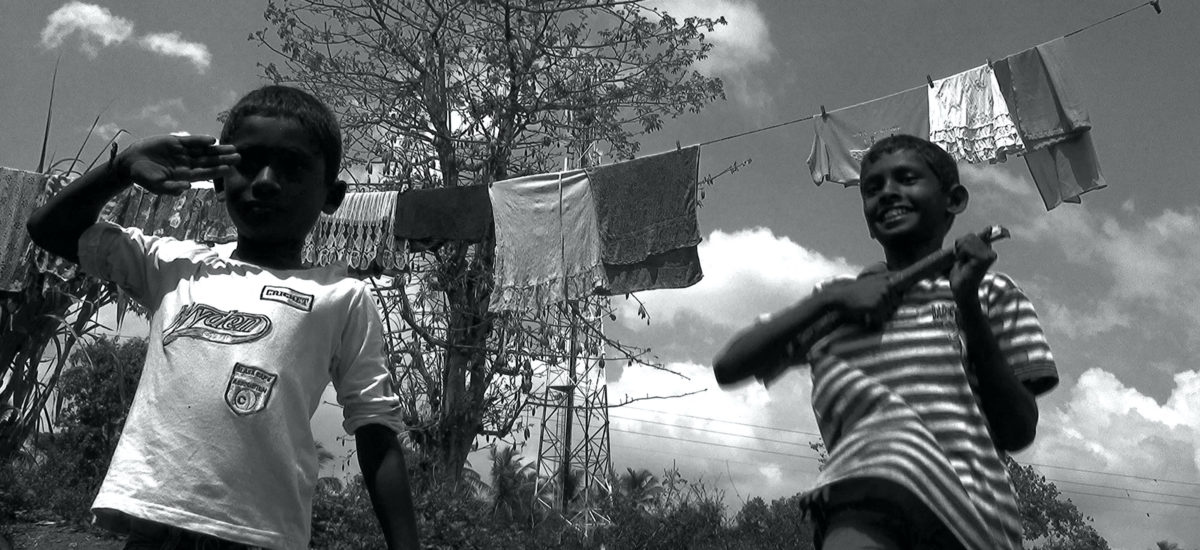Photo courtesy of Waruni Anuruddhika
Today is International Youth Day
Their playground is a graveyard; their toys are sticks and stones. They run in the sand and dirt, flying kites and joking, fighting and laughing.
They are Tamil children living on the edge of a cemetery in Veyangoda. The desire for a better life away from the grinding poverty and hopelessness of the tea estates brought their ancestors to this Sinhala area in the 1950s. Some people migrated from Colombo while others came from the North and other parts of the country, mainly due to marriage.
The first man to arrive built a temporary house in the cemetery with permission from the local council. In 1956, the government built eight lines of semi-permanent houses for those who worked as labourers at the Town Council. In 1964, there were another eight lines houses built by the government. Since then, no renovations have been carried out on the houses.
In the past 70 years, conditions have improved but only marginally. The men are still labourers but with government jobs at the Veyangoda Town Council or they are manual workers doing odd jobs. The women stay at home; the lack of education has prevented them from being able to get a worthwhile job.
Film maker Waruni Anuruddhika stumbled across the community after reading a newspaper article and was inspired to make a documentary, which was completed in 2014, called Children of Cemetery Dwellers. “I was shocked to see the conditions of the lives of these people living in a temporary housing at the edge of a public cemetery. They were and are struggling to fulfill their basic needs. I was moved by seeing their endless struggle to make a life as well as their worries about the education of their children,” said Waruni in an interview.
“I realised that access to education, which is the only option poor people have for social mobility, has been obstructed by marginalising them on various grounds such as class, caste, regionalism, ethnicity and so on. I felt that I needed to bring these issues to light and give the community a voice,” she added.
In the documentary, the children are shown doing what children do, living a mostly carefree life. But their parents, mothers actually, are determined to give them better opportunities than they had. The mothers stressed the importance of education so that their children could get employment in a shop or a factory and without having to rely on manual labour. One mother describes how she had only one dress when she was going to school – no shoes or underwear. The dress was “ironed” with two bottles of hot water and worn even if damp. So she started cutting classes and eventually dropped out of school, got married and had children of her own. Another mother expressed regret that she had not finished her education, saying it had prevented her from getting a decent job.
When the film was made, there were 51 households with 98 school age children. No adult has passed O’Levels. The number of households has now increased to 64 families.
Waruni has returned to the community many times to participate in family functions and attend cultural events. She has managed to find them some assistance from NGOs, activists and academics. A small library for the children has been set up and English classes were conducted. Government officials are trying to establish permanent houses, although this project has moved at a slow pace and families still live in temporary shelters with few facilities.
Some social issues have remained the same. “The school dropout rate and the number of early marriages in the community are still high. Most of the children who were featured in the film have already stopped schooling and are working as manual labourers. Two of the girls got married and one of them had her first child in 2019. Only one girl could finish her advanced level exam and is looking for a job,” Waruni stated.
“Most of the community members – men, women and children – are working as wage labourers. Many are garbage collectors of the municipal councils. Some women have migrated to Middle East and a few young women are working in the garment factories. Due to the uncertainty of their professions and low income level, they were caught into vicious cycle of poverty and debt. Consequently, most of the young girls seek early marriages as way of escaping poverty. The high rate of malnutrition among children, low level of educational achievements and high rate of school dropout are some of the serious issues,” commented Waruni.
Education is seen as a way out of the poverty trap. One girl aspired to be a doctor and a boy intended to join the army while another girl wanted a job in a garment factory.
The documentary shows how the community is discriminated against when it comes to sending their children to school. Despite having all the documentation, including proof of residence, schools nearby have refused to admit them and the children have to go elsewhere. “Rich people can go anywhere, it’s only poor people who cannot,” said one mother. Another one is bitter, saying that she felt like destroying the school she passes each day while taking her children to another school that was not as good.
“The children are studying at government schools. Although their houses are within the range of 500 metres of Veyangoda city, they are not enrolled in nearby schools; they are excluded due to their low social and economic status as well as ethnic identity. Sometimes parents are not aware of the documentation process and miss the deadline for submission of applications or find difficulties preparing relevant documents,” Waruni pointed out.
The documentary begins with the children singing the national anthem in Sinhala. The mothers and the children spoke about being taunted and insulted for their Tamil heritage. They speak Sinhala and have taken Sinhala names. “Then they won’t tease us because they won’t know we are Tamil,” a young girl said. One mother doesn’t allow her children to speak Tamil, saying that there is no need to know the language.
“I don’t think that they will lose their cultural identity. They use Sinhala names to camouflage their ethnic identity in order to prevent the discrimination in the public sphere, particularly in school. I think that their ethnic identity might be reconfigured. I noticed that some of the children cannot write or read in Tamil although they speak in Tamil. I would say celebration of their cultural festivals are a way of revitalising their ethnic and cultural identity. The annual Pattini parade is the best example of this. It showcases the mixture of Sinhala and Tamil ritual of worshipping goddess Pattini,” Waruni pointed out.
There is much to be done to develop the community and, in particular, the next generation. “It is important to establish equal opportunities in access to education. Along with that, a financial support system should be arranged until they finish their secondary education. Providing a better housing facility and livelihood system along with advocacy is needed to improve community life, which is essential to uplift their dignity,” Waruni concluded.


